Academy of Management Review: Stakeholder Theory and Advantage
VerifiedAdded on 2022/08/25
|55
|22565
|26
Report
AI Summary
This report, extracted from an Academy of Management Review manuscript, delves into instrumental stakeholder theory (IST) and its potential to provide sustainable competitive advantage. It addresses the limitations of current IST literature, specifically the lack of theory on how IST can lead to sustainable competitive advantage, the neglect of potential downsides of stakeholder relationships, and the limited understanding of contextual factors. The authors propose a theoretical framework that links a communal sharing relational ethics strategy to a close relationship capability, which they argue is valuable, rare, and difficult to imitate, thus offering a source of sustainable competitive advantage. The report also considers the costs associated with developing this capability and identifies contexts where it is most likely to yield the greatest net value. Furthermore, it emphasizes the importance of relational theory in understanding the interactions between managers and stakeholders, advocating for an approach that examines the nature of these relationships to better understand how IST prescriptions can lead to sustainable competitive advantage.
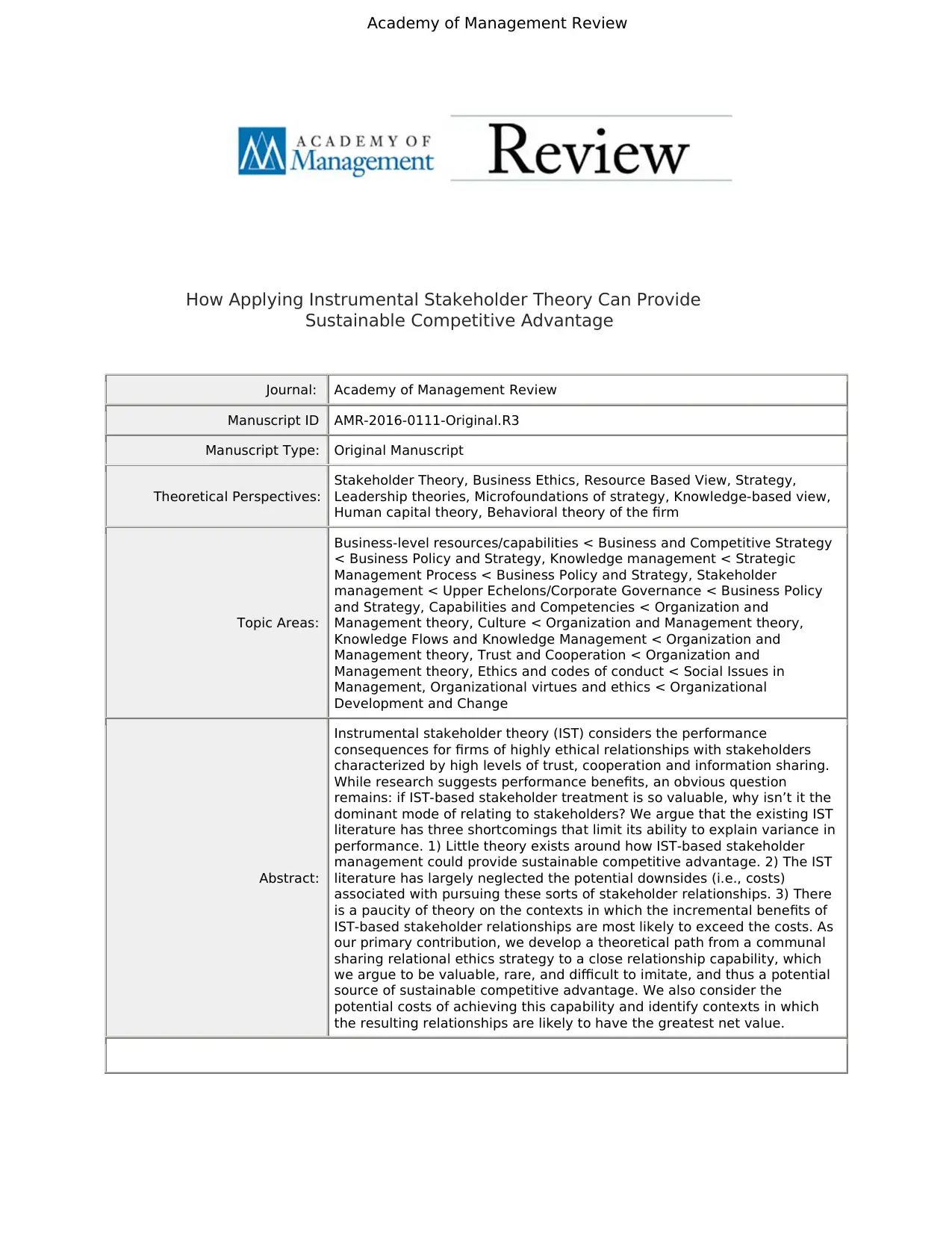
How Applying Instrumental Stakeholder Theory Can Provide
Sustainable Competitive Advantage
Journal: Academy of Management Review
Manuscript ID AMR-2016-0111-Original.R3
Manuscript Type: Original Manuscript
Theoretical Perspectives:
Stakeholder Theory, Business Ethics, Resource Based View, Strategy,
Leadership theories, Microfoundations of strategy, Knowledge-based view,
Human capital theory, Behavioral theory of the firm
Topic Areas:
Business-level resources/capabilities < Business and Competitive Strategy
< Business Policy and Strategy, Knowledge management < Strategic
Management Process < Business Policy and Strategy, Stakeholder
management < Upper Echelons/Corporate Governance < Business Policy
and Strategy, Capabilities and Competencies < Organization and
Management theory, Culture < Organization and Management theory,
Knowledge Flows and Knowledge Management < Organization and
Management theory, Trust and Cooperation < Organization and
Management theory, Ethics and codes of conduct < Social Issues in
Management, Organizational virtues and ethics < Organizational
Development and Change
Abstract:
Instrumental stakeholder theory (IST) considers the performance
consequences for firms of highly ethical relationships with stakeholders
characterized by high levels of trust, cooperation and information sharing.
While research suggests performance benefits, an obvious question
remains: if IST-based stakeholder treatment is so valuable, why isn’t it the
dominant mode of relating to stakeholders? We argue that the existing IST
literature has three shortcomings that limit its ability to explain variance in
performance. 1) Little theory exists around how IST-based stakeholder
management could provide sustainable competitive advantage. 2) The IST
literature has largely neglected the potential downsides (i.e., costs)
associated with pursuing these sorts of stakeholder relationships. 3) There
is a paucity of theory on the contexts in which the incremental benefits of
IST-based stakeholder relationships are most likely to exceed the costs. As
our primary contribution, we develop a theoretical path from a communal
sharing relational ethics strategy to a close relationship capability, which
we argue to be valuable, rare, and difficult to imitate, and thus a potential
source of sustainable competitive advantage. We also consider the
potential costs of achieving this capability and identify contexts in which
the resulting relationships are likely to have the greatest net value.
Academy of Management Review
Sustainable Competitive Advantage
Journal: Academy of Management Review
Manuscript ID AMR-2016-0111-Original.R3
Manuscript Type: Original Manuscript
Theoretical Perspectives:
Stakeholder Theory, Business Ethics, Resource Based View, Strategy,
Leadership theories, Microfoundations of strategy, Knowledge-based view,
Human capital theory, Behavioral theory of the firm
Topic Areas:
Business-level resources/capabilities < Business and Competitive Strategy
< Business Policy and Strategy, Knowledge management < Strategic
Management Process < Business Policy and Strategy, Stakeholder
management < Upper Echelons/Corporate Governance < Business Policy
and Strategy, Capabilities and Competencies < Organization and
Management theory, Culture < Organization and Management theory,
Knowledge Flows and Knowledge Management < Organization and
Management theory, Trust and Cooperation < Organization and
Management theory, Ethics and codes of conduct < Social Issues in
Management, Organizational virtues and ethics < Organizational
Development and Change
Abstract:
Instrumental stakeholder theory (IST) considers the performance
consequences for firms of highly ethical relationships with stakeholders
characterized by high levels of trust, cooperation and information sharing.
While research suggests performance benefits, an obvious question
remains: if IST-based stakeholder treatment is so valuable, why isn’t it the
dominant mode of relating to stakeholders? We argue that the existing IST
literature has three shortcomings that limit its ability to explain variance in
performance. 1) Little theory exists around how IST-based stakeholder
management could provide sustainable competitive advantage. 2) The IST
literature has largely neglected the potential downsides (i.e., costs)
associated with pursuing these sorts of stakeholder relationships. 3) There
is a paucity of theory on the contexts in which the incremental benefits of
IST-based stakeholder relationships are most likely to exceed the costs. As
our primary contribution, we develop a theoretical path from a communal
sharing relational ethics strategy to a close relationship capability, which
we argue to be valuable, rare, and difficult to imitate, and thus a potential
source of sustainable competitive advantage. We also consider the
potential costs of achieving this capability and identify contexts in which
the resulting relationships are likely to have the greatest net value.
Academy of Management Review
Paraphrase This Document
Need a fresh take? Get an instant paraphrase of this document with our AI Paraphraser

Page 1 of 53 Academy of Management Review
1
2
3
4
5
6
7
8
9
10
11
12
13
14
15
16
17
18
19
20
21
22
23
24
25
26
27
28
29
30
31
32
33
34
35
36
37
38
39
40
41
42
43
44
45
46
47
48
49
50
51
52
53
54
55
56
57
58
59
60
1
2
3
4
5
6
7
8
9
10
11
12
13
14
15
16
17
18
19
20
21
22
23
24
25
26
27
28
29
30
31
32
33
34
35
36
37
38
39
40
41
42
43
44
45
46
47
48
49
50
51
52
53
54
55
56
57
58
59
60
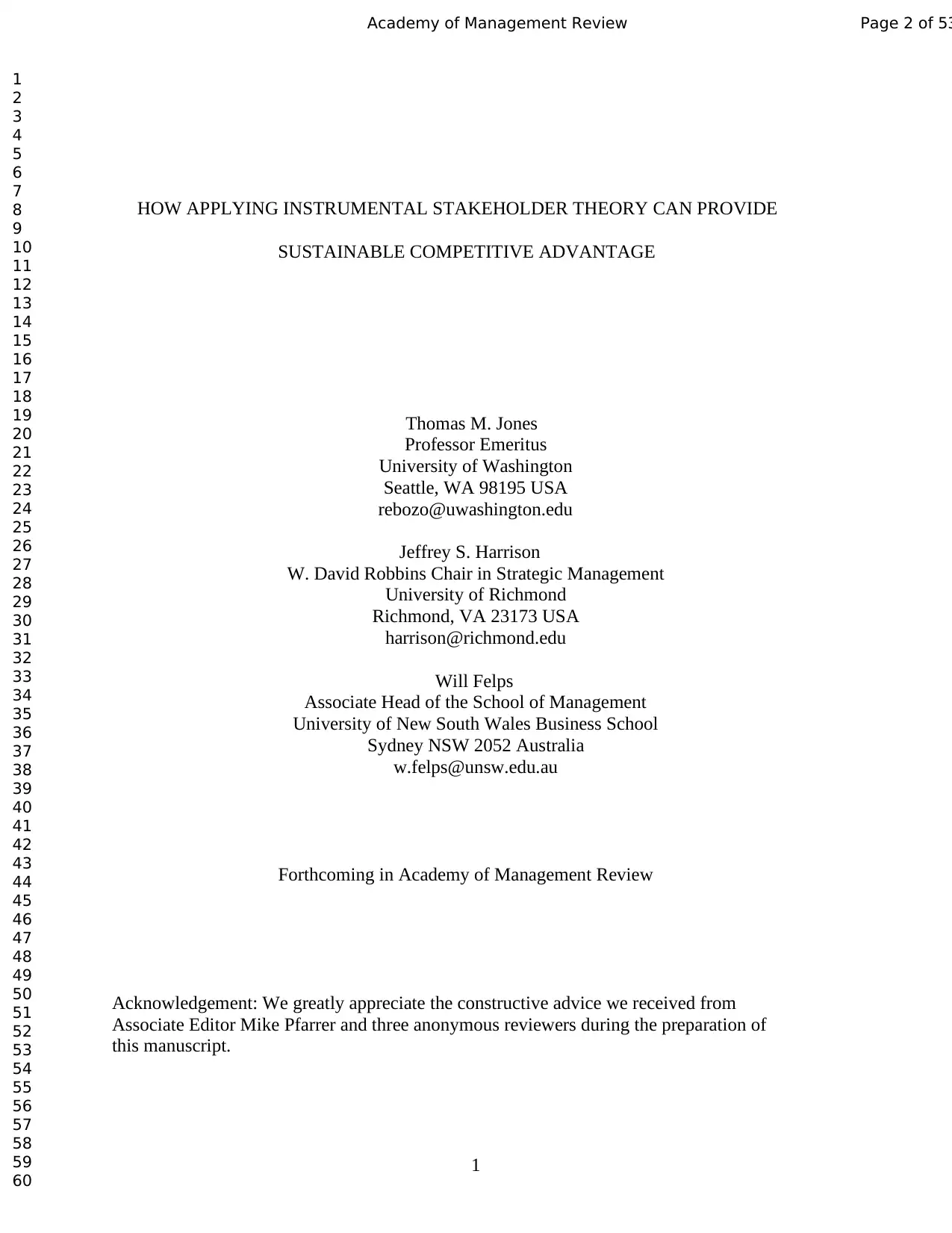
1
HOW APPLYING INSTRUMENTAL STAKEHOLDER THEORY CAN PROVIDE
SUSTAINABLE COMPETITIVE ADVANTAGE
Thomas M. Jones
Professor Emeritus
University of Washington
Seattle, WA 98195 USA
rebozo@uwashington.edu
Jeffrey S. Harrison
W. David Robbins Chair in Strategic Management
University of Richmond
Richmond, VA 23173 USA
harrison@richmond.edu
Will Felps
Associate Head of the School of Management
University of New South Wales Business School
Sydney NSW 2052 Australia
w.felps@unsw.edu.au
Forthcoming in Academy of Management Review
Acknowledgement: We greatly appreciate the constructive advice we received from
Associate Editor Mike Pfarrer and three anonymous reviewers during the preparation of
this manuscript.
Page 2 of 53Academy of Management Review
1
2
3
4
5
6
7
8
9
10
11
12
13
14
15
16
17
18
19
20
21
22
23
24
25
26
27
28
29
30
31
32
33
34
35
36
37
38
39
40
41
42
43
44
45
46
47
48
49
50
51
52
53
54
55
56
57
58
59
60
HOW APPLYING INSTRUMENTAL STAKEHOLDER THEORY CAN PROVIDE
SUSTAINABLE COMPETITIVE ADVANTAGE
Thomas M. Jones
Professor Emeritus
University of Washington
Seattle, WA 98195 USA
rebozo@uwashington.edu
Jeffrey S. Harrison
W. David Robbins Chair in Strategic Management
University of Richmond
Richmond, VA 23173 USA
harrison@richmond.edu
Will Felps
Associate Head of the School of Management
University of New South Wales Business School
Sydney NSW 2052 Australia
w.felps@unsw.edu.au
Forthcoming in Academy of Management Review
Acknowledgement: We greatly appreciate the constructive advice we received from
Associate Editor Mike Pfarrer and three anonymous reviewers during the preparation of
this manuscript.
Page 2 of 53Academy of Management Review
1
2
3
4
5
6
7
8
9
10
11
12
13
14
15
16
17
18
19
20
21
22
23
24
25
26
27
28
29
30
31
32
33
34
35
36
37
38
39
40
41
42
43
44
45
46
47
48
49
50
51
52
53
54
55
56
57
58
59
60
⊘ This is a preview!⊘
Do you want full access?
Subscribe today to unlock all pages.

Trusted by 1+ million students worldwide
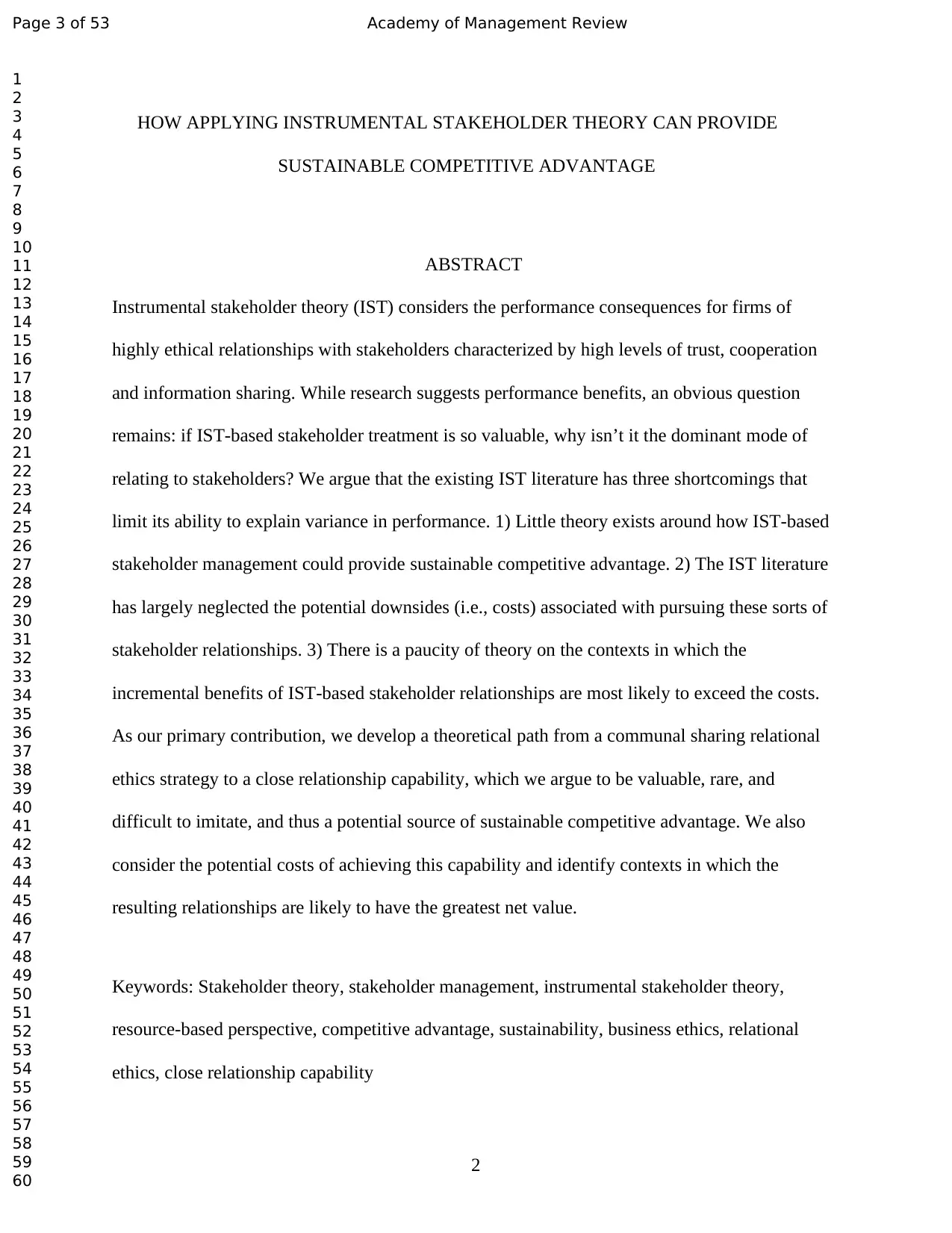
2
HOW APPLYING INSTRUMENTAL STAKEHOLDER THEORY CAN PROVIDE
SUSTAINABLE COMPETITIVE ADVANTAGE
ABSTRACT
Instrumental stakeholder theory (IST) considers the performance consequences for firms of
highly ethical relationships with stakeholders characterized by high levels of trust, cooperation
and information sharing. While research suggests performance benefits, an obvious question
remains: if IST-based stakeholder treatment is so valuable, why isn’t it the dominant mode of
relating to stakeholders? We argue that the existing IST literature has three shortcomings that
limit its ability to explain variance in performance. 1) Little theory exists around how IST-based
stakeholder management could provide sustainable competitive advantage. 2) The IST literature
has largely neglected the potential downsides (i.e., costs) associated with pursuing these sorts of
stakeholder relationships. 3) There is a paucity of theory on the contexts in which the
incremental benefits of IST-based stakeholder relationships are most likely to exceed the costs.
As our primary contribution, we develop a theoretical path from a communal sharing relational
ethics strategy to a close relationship capability, which we argue to be valuable, rare, and
difficult to imitate, and thus a potential source of sustainable competitive advantage. We also
consider the potential costs of achieving this capability and identify contexts in which the
resulting relationships are likely to have the greatest net value.
Keywords: Stakeholder theory, stakeholder management, instrumental stakeholder theory,
resource-based perspective, competitive advantage, sustainability, business ethics, relational
ethics, close relationship capability
Page 3 of 53 Academy of Management Review
1
2
3
4
5
6
7
8
9
10
11
12
13
14
15
16
17
18
19
20
21
22
23
24
25
26
27
28
29
30
31
32
33
34
35
36
37
38
39
40
41
42
43
44
45
46
47
48
49
50
51
52
53
54
55
56
57
58
59
60
HOW APPLYING INSTRUMENTAL STAKEHOLDER THEORY CAN PROVIDE
SUSTAINABLE COMPETITIVE ADVANTAGE
ABSTRACT
Instrumental stakeholder theory (IST) considers the performance consequences for firms of
highly ethical relationships with stakeholders characterized by high levels of trust, cooperation
and information sharing. While research suggests performance benefits, an obvious question
remains: if IST-based stakeholder treatment is so valuable, why isn’t it the dominant mode of
relating to stakeholders? We argue that the existing IST literature has three shortcomings that
limit its ability to explain variance in performance. 1) Little theory exists around how IST-based
stakeholder management could provide sustainable competitive advantage. 2) The IST literature
has largely neglected the potential downsides (i.e., costs) associated with pursuing these sorts of
stakeholder relationships. 3) There is a paucity of theory on the contexts in which the
incremental benefits of IST-based stakeholder relationships are most likely to exceed the costs.
As our primary contribution, we develop a theoretical path from a communal sharing relational
ethics strategy to a close relationship capability, which we argue to be valuable, rare, and
difficult to imitate, and thus a potential source of sustainable competitive advantage. We also
consider the potential costs of achieving this capability and identify contexts in which the
resulting relationships are likely to have the greatest net value.
Keywords: Stakeholder theory, stakeholder management, instrumental stakeholder theory,
resource-based perspective, competitive advantage, sustainability, business ethics, relational
ethics, close relationship capability
Page 3 of 53 Academy of Management Review
1
2
3
4
5
6
7
8
9
10
11
12
13
14
15
16
17
18
19
20
21
22
23
24
25
26
27
28
29
30
31
32
33
34
35
36
37
38
39
40
41
42
43
44
45
46
47
48
49
50
51
52
53
54
55
56
57
58
59
60
Paraphrase This Document
Need a fresh take? Get an instant paraphrase of this document with our AI Paraphraser
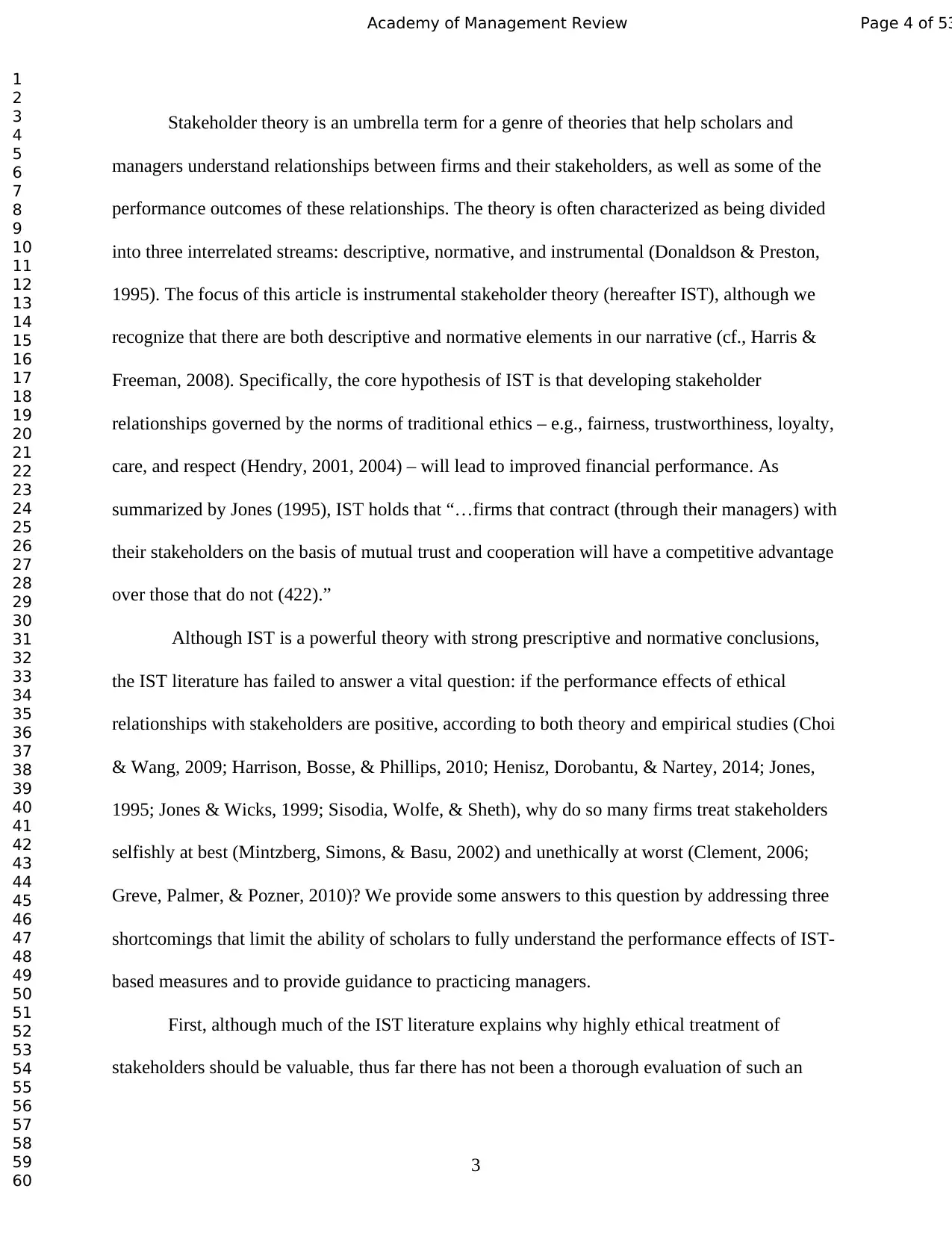
3
Stakeholder theory is an umbrella term for a genre of theories that help scholars and
managers understand relationships between firms and their stakeholders, as well as some of the
performance outcomes of these relationships. The theory is often characterized as being divided
into three interrelated streams: descriptive, normative, and instrumental (Donaldson & Preston,
1995). The focus of this article is instrumental stakeholder theory (hereafter IST), although we
recognize that there are both descriptive and normative elements in our narrative (cf., Harris &
Freeman, 2008). Specifically, the core hypothesis of IST is that developing stakeholder
relationships governed by the norms of traditional ethics – e.g., fairness, trustworthiness, loyalty,
care, and respect (Hendry, 2001, 2004) – will lead to improved financial performance. As
summarized by Jones (1995), IST holds that “…firms that contract (through their managers) with
their stakeholders on the basis of mutual trust and cooperation will have a competitive advantage
over those that do not (422).”
Although IST is a powerful theory with strong prescriptive and normative conclusions,
the IST literature has failed to answer a vital question: if the performance effects of ethical
relationships with stakeholders are positive, according to both theory and empirical studies (Choi
& Wang, 2009; Harrison, Bosse, & Phillips, 2010; Henisz, Dorobantu, & Nartey, 2014; Jones,
1995; Jones & Wicks, 1999; Sisodia, Wolfe, & Sheth), why do so many firms treat stakeholders
selfishly at best (Mintzberg, Simons, & Basu, 2002) and unethically at worst (Clement, 2006;
Greve, Palmer, & Pozner, 2010)? We provide some answers to this question by addressing three
shortcomings that limit the ability of scholars to fully understand the performance effects of IST-
based measures and to provide guidance to practicing managers.
First, although much of the IST literature explains why highly ethical treatment of
stakeholders should be valuable, thus far there has not been a thorough evaluation of such an
Page 4 of 53Academy of Management Review
1
2
3
4
5
6
7
8
9
10
11
12
13
14
15
16
17
18
19
20
21
22
23
24
25
26
27
28
29
30
31
32
33
34
35
36
37
38
39
40
41
42
43
44
45
46
47
48
49
50
51
52
53
54
55
56
57
58
59
60
Stakeholder theory is an umbrella term for a genre of theories that help scholars and
managers understand relationships between firms and their stakeholders, as well as some of the
performance outcomes of these relationships. The theory is often characterized as being divided
into three interrelated streams: descriptive, normative, and instrumental (Donaldson & Preston,
1995). The focus of this article is instrumental stakeholder theory (hereafter IST), although we
recognize that there are both descriptive and normative elements in our narrative (cf., Harris &
Freeman, 2008). Specifically, the core hypothesis of IST is that developing stakeholder
relationships governed by the norms of traditional ethics – e.g., fairness, trustworthiness, loyalty,
care, and respect (Hendry, 2001, 2004) – will lead to improved financial performance. As
summarized by Jones (1995), IST holds that “…firms that contract (through their managers) with
their stakeholders on the basis of mutual trust and cooperation will have a competitive advantage
over those that do not (422).”
Although IST is a powerful theory with strong prescriptive and normative conclusions,
the IST literature has failed to answer a vital question: if the performance effects of ethical
relationships with stakeholders are positive, according to both theory and empirical studies (Choi
& Wang, 2009; Harrison, Bosse, & Phillips, 2010; Henisz, Dorobantu, & Nartey, 2014; Jones,
1995; Jones & Wicks, 1999; Sisodia, Wolfe, & Sheth), why do so many firms treat stakeholders
selfishly at best (Mintzberg, Simons, & Basu, 2002) and unethically at worst (Clement, 2006;
Greve, Palmer, & Pozner, 2010)? We provide some answers to this question by addressing three
shortcomings that limit the ability of scholars to fully understand the performance effects of IST-
based measures and to provide guidance to practicing managers.
First, although much of the IST literature explains why highly ethical treatment of
stakeholders should be valuable, thus far there has not been a thorough evaluation of such an
Page 4 of 53Academy of Management Review
1
2
3
4
5
6
7
8
9
10
11
12
13
14
15
16
17
18
19
20
21
22
23
24
25
26
27
28
29
30
31
32
33
34
35
36
37
38
39
40
41
42
43
44
45
46
47
48
49
50
51
52
53
54
55
56
57
58
59
60
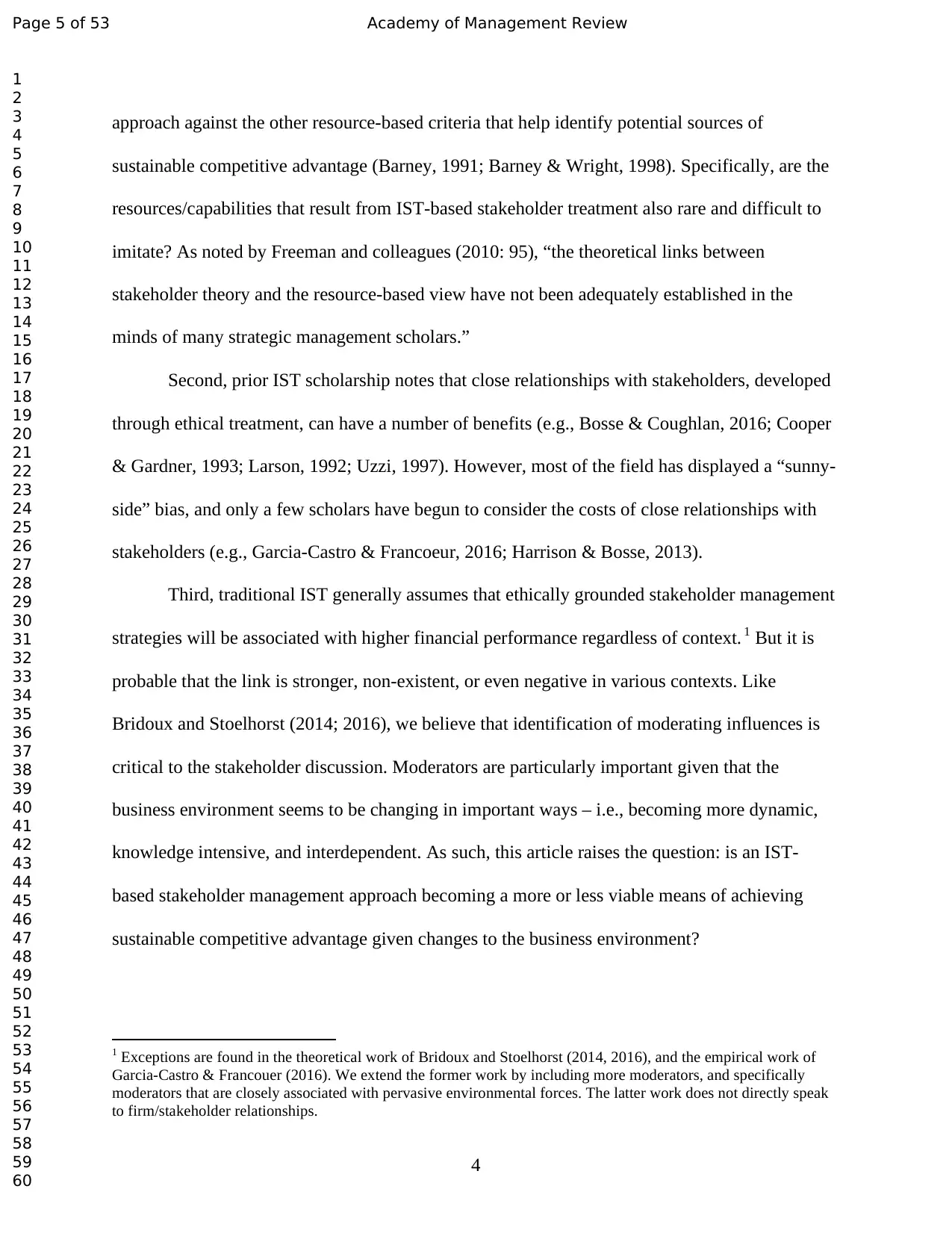
4
approach against the other resource-based criteria that help identify potential sources of
sustainable competitive advantage (Barney, 1991; Barney & Wright, 1998). Specifically, are the
resources/capabilities that result from IST-based stakeholder treatment also rare and difficult to
imitate? As noted by Freeman and colleagues (2010: 95), “the theoretical links between
stakeholder theory and the resource-based view have not been adequately established in the
minds of many strategic management scholars.”
Second, prior IST scholarship notes that close relationships with stakeholders, developed
through ethical treatment, can have a number of benefits (e.g., Bosse & Coughlan, 2016; Cooper
& Gardner, 1993; Larson, 1992; Uzzi, 1997). However, most of the field has displayed a “sunny-
side” bias, and only a few scholars have begun to consider the costs of close relationships with
stakeholders (e.g., Garcia-Castro & Francoeur, 2016; Harrison & Bosse, 2013).
Third, traditional IST generally assumes that ethically grounded stakeholder management
strategies will be associated with higher financial performance regardless of context. 1 But it is
probable that the link is stronger, non-existent, or even negative in various contexts. Like
Bridoux and Stoelhorst (2014; 2016), we believe that identification of moderating influences is
critical to the stakeholder discussion. Moderators are particularly important given that the
business environment seems to be changing in important ways – i.e., becoming more dynamic,
knowledge intensive, and interdependent. As such, this article raises the question: is an IST-
based stakeholder management approach becoming a more or less viable means of achieving
sustainable competitive advantage given changes to the business environment?
1 Exceptions are found in the theoretical work of Bridoux and Stoelhorst (2014, 2016), and the empirical work of
Garcia-Castro & Francouer (2016). We extend the former work by including more moderators, and specifically
moderators that are closely associated with pervasive environmental forces. The latter work does not directly speak
to firm/stakeholder relationships.
Page 5 of 53 Academy of Management Review
1
2
3
4
5
6
7
8
9
10
11
12
13
14
15
16
17
18
19
20
21
22
23
24
25
26
27
28
29
30
31
32
33
34
35
36
37
38
39
40
41
42
43
44
45
46
47
48
49
50
51
52
53
54
55
56
57
58
59
60
approach against the other resource-based criteria that help identify potential sources of
sustainable competitive advantage (Barney, 1991; Barney & Wright, 1998). Specifically, are the
resources/capabilities that result from IST-based stakeholder treatment also rare and difficult to
imitate? As noted by Freeman and colleagues (2010: 95), “the theoretical links between
stakeholder theory and the resource-based view have not been adequately established in the
minds of many strategic management scholars.”
Second, prior IST scholarship notes that close relationships with stakeholders, developed
through ethical treatment, can have a number of benefits (e.g., Bosse & Coughlan, 2016; Cooper
& Gardner, 1993; Larson, 1992; Uzzi, 1997). However, most of the field has displayed a “sunny-
side” bias, and only a few scholars have begun to consider the costs of close relationships with
stakeholders (e.g., Garcia-Castro & Francoeur, 2016; Harrison & Bosse, 2013).
Third, traditional IST generally assumes that ethically grounded stakeholder management
strategies will be associated with higher financial performance regardless of context. 1 But it is
probable that the link is stronger, non-existent, or even negative in various contexts. Like
Bridoux and Stoelhorst (2014; 2016), we believe that identification of moderating influences is
critical to the stakeholder discussion. Moderators are particularly important given that the
business environment seems to be changing in important ways – i.e., becoming more dynamic,
knowledge intensive, and interdependent. As such, this article raises the question: is an IST-
based stakeholder management approach becoming a more or less viable means of achieving
sustainable competitive advantage given changes to the business environment?
1 Exceptions are found in the theoretical work of Bridoux and Stoelhorst (2014, 2016), and the empirical work of
Garcia-Castro & Francouer (2016). We extend the former work by including more moderators, and specifically
moderators that are closely associated with pervasive environmental forces. The latter work does not directly speak
to firm/stakeholder relationships.
Page 5 of 53 Academy of Management Review
1
2
3
4
5
6
7
8
9
10
11
12
13
14
15
16
17
18
19
20
21
22
23
24
25
26
27
28
29
30
31
32
33
34
35
36
37
38
39
40
41
42
43
44
45
46
47
48
49
50
51
52
53
54
55
56
57
58
59
60
⊘ This is a preview!⊘
Do you want full access?
Subscribe today to unlock all pages.

Trusted by 1+ million students worldwide
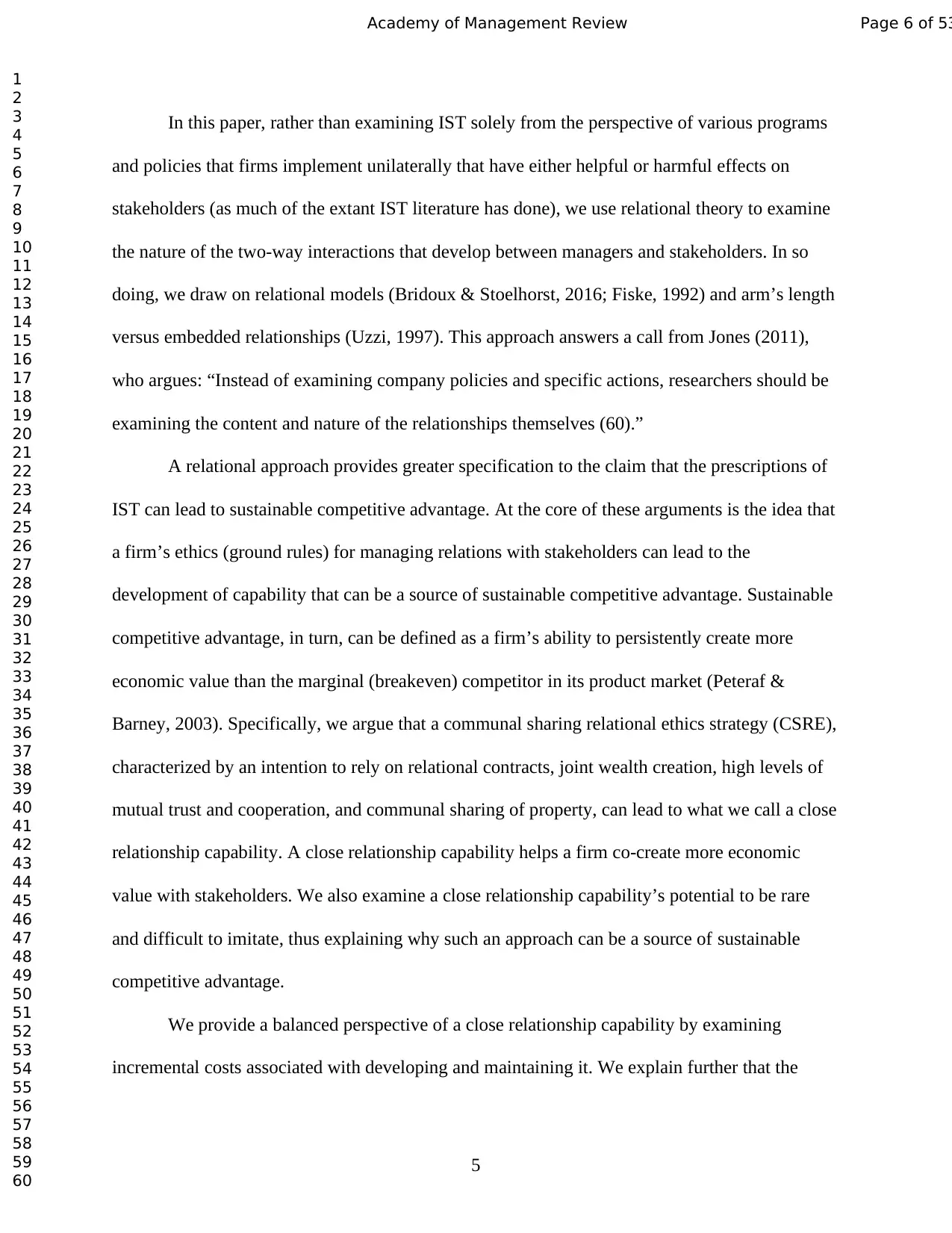
5
In this paper, rather than examining IST solely from the perspective of various programs
and policies that firms implement unilaterally that have either helpful or harmful effects on
stakeholders (as much of the extant IST literature has done), we use relational theory to examine
the nature of the two-way interactions that develop between managers and stakeholders. In so
doing, we draw on relational models (Bridoux & Stoelhorst, 2016; Fiske, 1992) and arm’s length
versus embedded relationships (Uzzi, 1997). This approach answers a call from Jones (2011),
who argues: “Instead of examining company policies and specific actions, researchers should be
examining the content and nature of the relationships themselves (60).”
A relational approach provides greater specification to the claim that the prescriptions of
IST can lead to sustainable competitive advantage. At the core of these arguments is the idea that
a firm’s ethics (ground rules) for managing relations with stakeholders can lead to the
development of capability that can be a source of sustainable competitive advantage. Sustainable
competitive advantage, in turn, can be defined as a firm’s ability to persistently create more
economic value than the marginal (breakeven) competitor in its product market (Peteraf &
Barney, 2003). Specifically, we argue that a communal sharing relational ethics strategy (CSRE),
characterized by an intention to rely on relational contracts, joint wealth creation, high levels of
mutual trust and cooperation, and communal sharing of property, can lead to what we call a close
relationship capability. A close relationship capability helps a firm co-create more economic
value with stakeholders. We also examine a close relationship capability’s potential to be rare
and difficult to imitate, thus explaining why such an approach can be a source of sustainable
competitive advantage.
We provide a balanced perspective of a close relationship capability by examining
incremental costs associated with developing and maintaining it. We explain further that the
Page 6 of 53Academy of Management Review
1
2
3
4
5
6
7
8
9
10
11
12
13
14
15
16
17
18
19
20
21
22
23
24
25
26
27
28
29
30
31
32
33
34
35
36
37
38
39
40
41
42
43
44
45
46
47
48
49
50
51
52
53
54
55
56
57
58
59
60
In this paper, rather than examining IST solely from the perspective of various programs
and policies that firms implement unilaterally that have either helpful or harmful effects on
stakeholders (as much of the extant IST literature has done), we use relational theory to examine
the nature of the two-way interactions that develop between managers and stakeholders. In so
doing, we draw on relational models (Bridoux & Stoelhorst, 2016; Fiske, 1992) and arm’s length
versus embedded relationships (Uzzi, 1997). This approach answers a call from Jones (2011),
who argues: “Instead of examining company policies and specific actions, researchers should be
examining the content and nature of the relationships themselves (60).”
A relational approach provides greater specification to the claim that the prescriptions of
IST can lead to sustainable competitive advantage. At the core of these arguments is the idea that
a firm’s ethics (ground rules) for managing relations with stakeholders can lead to the
development of capability that can be a source of sustainable competitive advantage. Sustainable
competitive advantage, in turn, can be defined as a firm’s ability to persistently create more
economic value than the marginal (breakeven) competitor in its product market (Peteraf &
Barney, 2003). Specifically, we argue that a communal sharing relational ethics strategy (CSRE),
characterized by an intention to rely on relational contracts, joint wealth creation, high levels of
mutual trust and cooperation, and communal sharing of property, can lead to what we call a close
relationship capability. A close relationship capability helps a firm co-create more economic
value with stakeholders. We also examine a close relationship capability’s potential to be rare
and difficult to imitate, thus explaining why such an approach can be a source of sustainable
competitive advantage.
We provide a balanced perspective of a close relationship capability by examining
incremental costs associated with developing and maintaining it. We explain further that the
Page 6 of 53Academy of Management Review
1
2
3
4
5
6
7
8
9
10
11
12
13
14
15
16
17
18
19
20
21
22
23
24
25
26
27
28
29
30
31
32
33
34
35
36
37
38
39
40
41
42
43
44
45
46
47
48
49
50
51
52
53
54
55
56
57
58
59
60
Paraphrase This Document
Need a fresh take? Get an instant paraphrase of this document with our AI Paraphraser
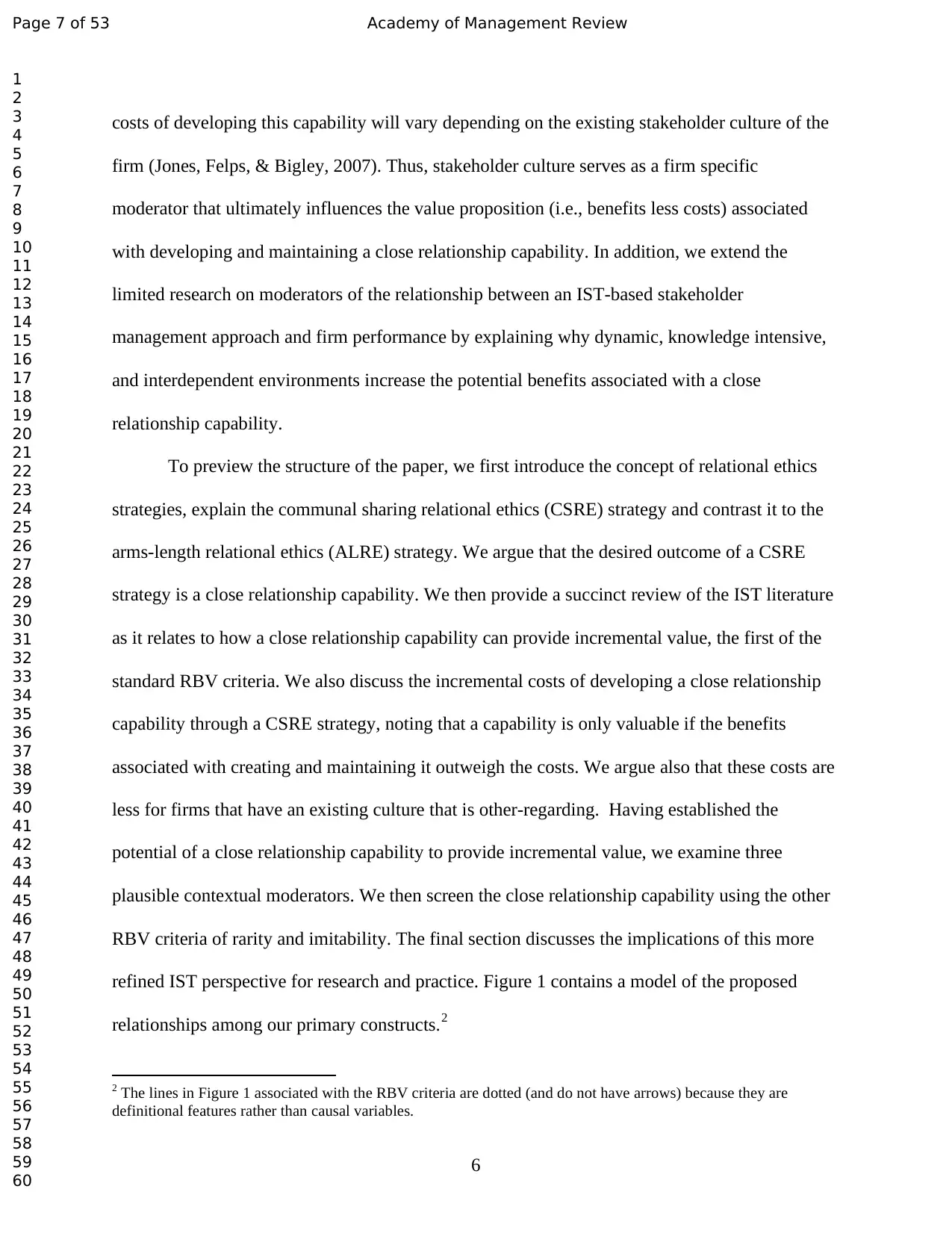
6
costs of developing this capability will vary depending on the existing stakeholder culture of the
firm (Jones, Felps, & Bigley, 2007). Thus, stakeholder culture serves as a firm specific
moderator that ultimately influences the value proposition (i.e., benefits less costs) associated
with developing and maintaining a close relationship capability. In addition, we extend the
limited research on moderators of the relationship between an IST-based stakeholder
management approach and firm performance by explaining why dynamic, knowledge intensive,
and interdependent environments increase the potential benefits associated with a close
relationship capability.
To preview the structure of the paper, we first introduce the concept of relational ethics
strategies, explain the communal sharing relational ethics (CSRE) strategy and contrast it to the
arms-length relational ethics (ALRE) strategy. We argue that the desired outcome of a CSRE
strategy is a close relationship capability. We then provide a succinct review of the IST literature
as it relates to how a close relationship capability can provide incremental value, the first of the
standard RBV criteria. We also discuss the incremental costs of developing a close relationship
capability through a CSRE strategy, noting that a capability is only valuable if the benefits
associated with creating and maintaining it outweigh the costs. We argue also that these costs are
less for firms that have an existing culture that is other-regarding. Having established the
potential of a close relationship capability to provide incremental value, we examine three
plausible contextual moderators. We then screen the close relationship capability using the other
RBV criteria of rarity and imitability. The final section discusses the implications of this more
refined IST perspective for research and practice. Figure 1 contains a model of the proposed
relationships among our primary constructs.2
2 The lines in Figure 1 associated with the RBV criteria are dotted (and do not have arrows) because they are
definitional features rather than causal variables.
Page 7 of 53 Academy of Management Review
1
2
3
4
5
6
7
8
9
10
11
12
13
14
15
16
17
18
19
20
21
22
23
24
25
26
27
28
29
30
31
32
33
34
35
36
37
38
39
40
41
42
43
44
45
46
47
48
49
50
51
52
53
54
55
56
57
58
59
60
costs of developing this capability will vary depending on the existing stakeholder culture of the
firm (Jones, Felps, & Bigley, 2007). Thus, stakeholder culture serves as a firm specific
moderator that ultimately influences the value proposition (i.e., benefits less costs) associated
with developing and maintaining a close relationship capability. In addition, we extend the
limited research on moderators of the relationship between an IST-based stakeholder
management approach and firm performance by explaining why dynamic, knowledge intensive,
and interdependent environments increase the potential benefits associated with a close
relationship capability.
To preview the structure of the paper, we first introduce the concept of relational ethics
strategies, explain the communal sharing relational ethics (CSRE) strategy and contrast it to the
arms-length relational ethics (ALRE) strategy. We argue that the desired outcome of a CSRE
strategy is a close relationship capability. We then provide a succinct review of the IST literature
as it relates to how a close relationship capability can provide incremental value, the first of the
standard RBV criteria. We also discuss the incremental costs of developing a close relationship
capability through a CSRE strategy, noting that a capability is only valuable if the benefits
associated with creating and maintaining it outweigh the costs. We argue also that these costs are
less for firms that have an existing culture that is other-regarding. Having established the
potential of a close relationship capability to provide incremental value, we examine three
plausible contextual moderators. We then screen the close relationship capability using the other
RBV criteria of rarity and imitability. The final section discusses the implications of this more
refined IST perspective for research and practice. Figure 1 contains a model of the proposed
relationships among our primary constructs.2
2 The lines in Figure 1 associated with the RBV criteria are dotted (and do not have arrows) because they are
definitional features rather than causal variables.
Page 7 of 53 Academy of Management Review
1
2
3
4
5
6
7
8
9
10
11
12
13
14
15
16
17
18
19
20
21
22
23
24
25
26
27
28
29
30
31
32
33
34
35
36
37
38
39
40
41
42
43
44
45
46
47
48
49
50
51
52
53
54
55
56
57
58
59
60
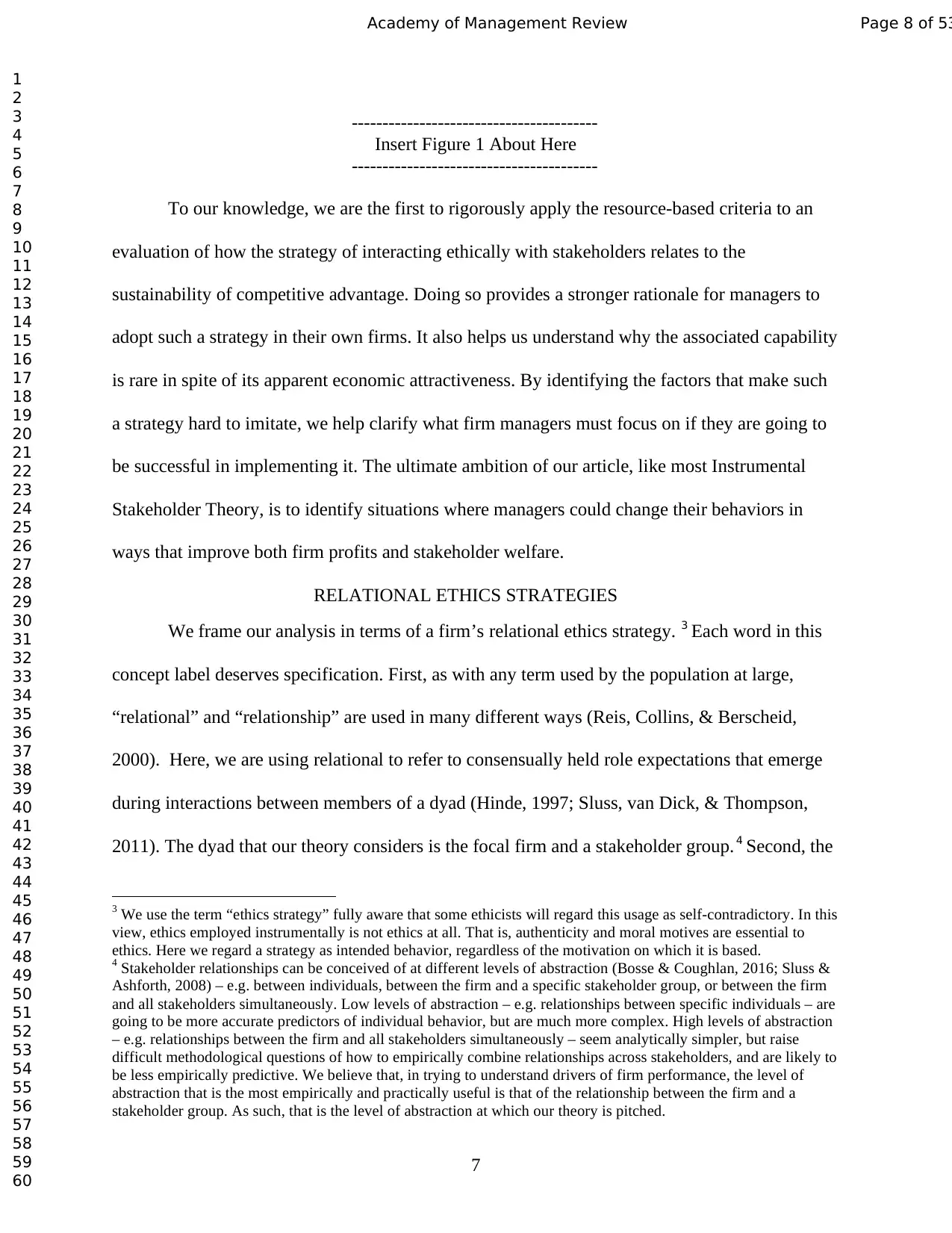
7
----------------------------------------
Insert Figure 1 About Here
----------------------------------------
To our knowledge, we are the first to rigorously apply the resource-based criteria to an
evaluation of how the strategy of interacting ethically with stakeholders relates to the
sustainability of competitive advantage. Doing so provides a stronger rationale for managers to
adopt such a strategy in their own firms. It also helps us understand why the associated capability
is rare in spite of its apparent economic attractiveness. By identifying the factors that make such
a strategy hard to imitate, we help clarify what firm managers must focus on if they are going to
be successful in implementing it. The ultimate ambition of our article, like most Instrumental
Stakeholder Theory, is to identify situations where managers could change their behaviors in
ways that improve both firm profits and stakeholder welfare.
RELATIONAL ETHICS STRATEGIES
We frame our analysis in terms of a firm’s relational ethics strategy. 3 Each word in this
concept label deserves specification. First, as with any term used by the population at large,
“relational” and “relationship” are used in many different ways (Reis, Collins, & Berscheid,
2000). Here, we are using relational to refer to consensually held role expectations that emerge
during interactions between members of a dyad (Hinde, 1997; Sluss, van Dick, & Thompson,
2011). The dyad that our theory considers is the focal firm and a stakeholder group.4 Second, the
3 We use the term “ethics strategy” fully aware that some ethicists will regard this usage as self-contradictory. In this
view, ethics employed instrumentally is not ethics at all. That is, authenticity and moral motives are essential to
ethics. Here we regard a strategy as intended behavior, regardless of the motivation on which it is based.
4 Stakeholder relationships can be conceived of at different levels of abstraction (Bosse & Coughlan, 2016; Sluss &
Ashforth, 2008) – e.g. between individuals, between the firm and a specific stakeholder group, or between the firm
and all stakeholders simultaneously. Low levels of abstraction – e.g. relationships between specific individuals – are
going to be more accurate predictors of individual behavior, but are much more complex. High levels of abstraction
– e.g. relationships between the firm and all stakeholders simultaneously – seem analytically simpler, but raise
difficult methodological questions of how to empirically combine relationships across stakeholders, and are likely to
be less empirically predictive. We believe that, in trying to understand drivers of firm performance, the level of
abstraction that is the most empirically and practically useful is that of the relationship between the firm and a
stakeholder group. As such, that is the level of abstraction at which our theory is pitched.
Page 8 of 53Academy of Management Review
1
2
3
4
5
6
7
8
9
10
11
12
13
14
15
16
17
18
19
20
21
22
23
24
25
26
27
28
29
30
31
32
33
34
35
36
37
38
39
40
41
42
43
44
45
46
47
48
49
50
51
52
53
54
55
56
57
58
59
60
----------------------------------------
Insert Figure 1 About Here
----------------------------------------
To our knowledge, we are the first to rigorously apply the resource-based criteria to an
evaluation of how the strategy of interacting ethically with stakeholders relates to the
sustainability of competitive advantage. Doing so provides a stronger rationale for managers to
adopt such a strategy in their own firms. It also helps us understand why the associated capability
is rare in spite of its apparent economic attractiveness. By identifying the factors that make such
a strategy hard to imitate, we help clarify what firm managers must focus on if they are going to
be successful in implementing it. The ultimate ambition of our article, like most Instrumental
Stakeholder Theory, is to identify situations where managers could change their behaviors in
ways that improve both firm profits and stakeholder welfare.
RELATIONAL ETHICS STRATEGIES
We frame our analysis in terms of a firm’s relational ethics strategy. 3 Each word in this
concept label deserves specification. First, as with any term used by the population at large,
“relational” and “relationship” are used in many different ways (Reis, Collins, & Berscheid,
2000). Here, we are using relational to refer to consensually held role expectations that emerge
during interactions between members of a dyad (Hinde, 1997; Sluss, van Dick, & Thompson,
2011). The dyad that our theory considers is the focal firm and a stakeholder group.4 Second, the
3 We use the term “ethics strategy” fully aware that some ethicists will regard this usage as self-contradictory. In this
view, ethics employed instrumentally is not ethics at all. That is, authenticity and moral motives are essential to
ethics. Here we regard a strategy as intended behavior, regardless of the motivation on which it is based.
4 Stakeholder relationships can be conceived of at different levels of abstraction (Bosse & Coughlan, 2016; Sluss &
Ashforth, 2008) – e.g. between individuals, between the firm and a specific stakeholder group, or between the firm
and all stakeholders simultaneously. Low levels of abstraction – e.g. relationships between specific individuals – are
going to be more accurate predictors of individual behavior, but are much more complex. High levels of abstraction
– e.g. relationships between the firm and all stakeholders simultaneously – seem analytically simpler, but raise
difficult methodological questions of how to empirically combine relationships across stakeholders, and are likely to
be less empirically predictive. We believe that, in trying to understand drivers of firm performance, the level of
abstraction that is the most empirically and practically useful is that of the relationship between the firm and a
stakeholder group. As such, that is the level of abstraction at which our theory is pitched.
Page 8 of 53Academy of Management Review
1
2
3
4
5
6
7
8
9
10
11
12
13
14
15
16
17
18
19
20
21
22
23
24
25
26
27
28
29
30
31
32
33
34
35
36
37
38
39
40
41
42
43
44
45
46
47
48
49
50
51
52
53
54
55
56
57
58
59
60
⊘ This is a preview!⊘
Do you want full access?
Subscribe today to unlock all pages.

Trusted by 1+ million students worldwide
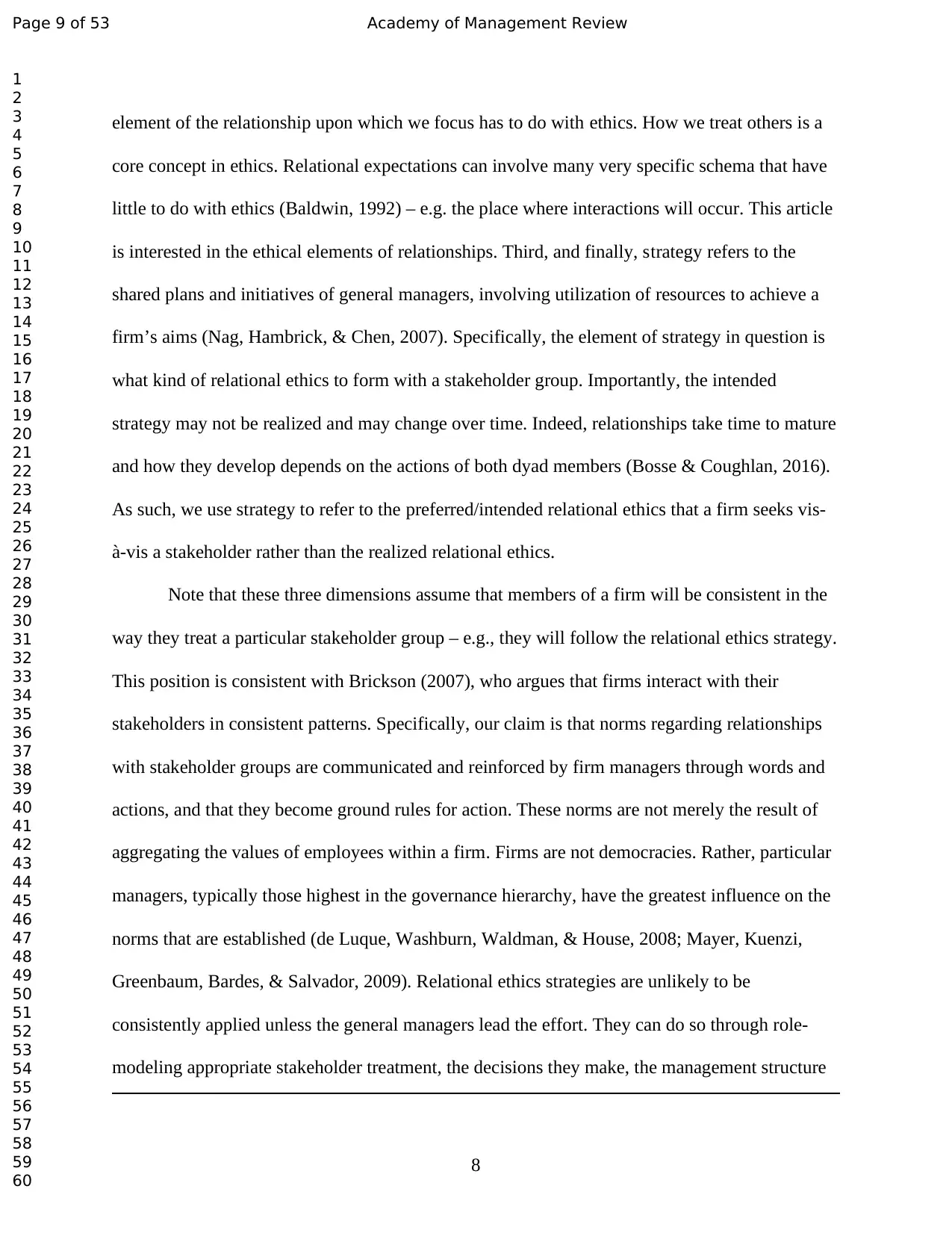
8
element of the relationship upon which we focus has to do with ethics. How we treat others is a
core concept in ethics. Relational expectations can involve many very specific schema that have
little to do with ethics (Baldwin, 1992) – e.g. the place where interactions will occur. This article
is interested in the ethical elements of relationships. Third, and finally, strategy refers to the
shared plans and initiatives of general managers, involving utilization of resources to achieve a
firm’s aims (Nag, Hambrick, & Chen, 2007). Specifically, the element of strategy in question is
what kind of relational ethics to form with a stakeholder group. Importantly, the intended
strategy may not be realized and may change over time. Indeed, relationships take time to mature
and how they develop depends on the actions of both dyad members (Bosse & Coughlan, 2016).
As such, we use strategy to refer to the preferred/intended relational ethics that a firm seeks vis-
à-vis a stakeholder rather than the realized relational ethics.
Note that these three dimensions assume that members of a firm will be consistent in the
way they treat a particular stakeholder group – e.g., they will follow the relational ethics strategy.
This position is consistent with Brickson (2007), who argues that firms interact with their
stakeholders in consistent patterns. Specifically, our claim is that norms regarding relationships
with stakeholder groups are communicated and reinforced by firm managers through words and
actions, and that they become ground rules for action. These norms are not merely the result of
aggregating the values of employees within a firm. Firms are not democracies. Rather, particular
managers, typically those highest in the governance hierarchy, have the greatest influence on the
norms that are established (de Luque, Washburn, Waldman, & House, 2008; Mayer, Kuenzi,
Greenbaum, Bardes, & Salvador, 2009). Relational ethics strategies are unlikely to be
consistently applied unless the general managers lead the effort. They can do so through role-
modeling appropriate stakeholder treatment, the decisions they make, the management structure
Page 9 of 53 Academy of Management Review
1
2
3
4
5
6
7
8
9
10
11
12
13
14
15
16
17
18
19
20
21
22
23
24
25
26
27
28
29
30
31
32
33
34
35
36
37
38
39
40
41
42
43
44
45
46
47
48
49
50
51
52
53
54
55
56
57
58
59
60
element of the relationship upon which we focus has to do with ethics. How we treat others is a
core concept in ethics. Relational expectations can involve many very specific schema that have
little to do with ethics (Baldwin, 1992) – e.g. the place where interactions will occur. This article
is interested in the ethical elements of relationships. Third, and finally, strategy refers to the
shared plans and initiatives of general managers, involving utilization of resources to achieve a
firm’s aims (Nag, Hambrick, & Chen, 2007). Specifically, the element of strategy in question is
what kind of relational ethics to form with a stakeholder group. Importantly, the intended
strategy may not be realized and may change over time. Indeed, relationships take time to mature
and how they develop depends on the actions of both dyad members (Bosse & Coughlan, 2016).
As such, we use strategy to refer to the preferred/intended relational ethics that a firm seeks vis-
à-vis a stakeholder rather than the realized relational ethics.
Note that these three dimensions assume that members of a firm will be consistent in the
way they treat a particular stakeholder group – e.g., they will follow the relational ethics strategy.
This position is consistent with Brickson (2007), who argues that firms interact with their
stakeholders in consistent patterns. Specifically, our claim is that norms regarding relationships
with stakeholder groups are communicated and reinforced by firm managers through words and
actions, and that they become ground rules for action. These norms are not merely the result of
aggregating the values of employees within a firm. Firms are not democracies. Rather, particular
managers, typically those highest in the governance hierarchy, have the greatest influence on the
norms that are established (de Luque, Washburn, Waldman, & House, 2008; Mayer, Kuenzi,
Greenbaum, Bardes, & Salvador, 2009). Relational ethics strategies are unlikely to be
consistently applied unless the general managers lead the effort. They can do so through role-
modeling appropriate stakeholder treatment, the decisions they make, the management structure
Page 9 of 53 Academy of Management Review
1
2
3
4
5
6
7
8
9
10
11
12
13
14
15
16
17
18
19
20
21
22
23
24
25
26
27
28
29
30
31
32
33
34
35
36
37
38
39
40
41
42
43
44
45
46
47
48
49
50
51
52
53
54
55
56
57
58
59
60
Paraphrase This Document
Need a fresh take? Get an instant paraphrase of this document with our AI Paraphraser
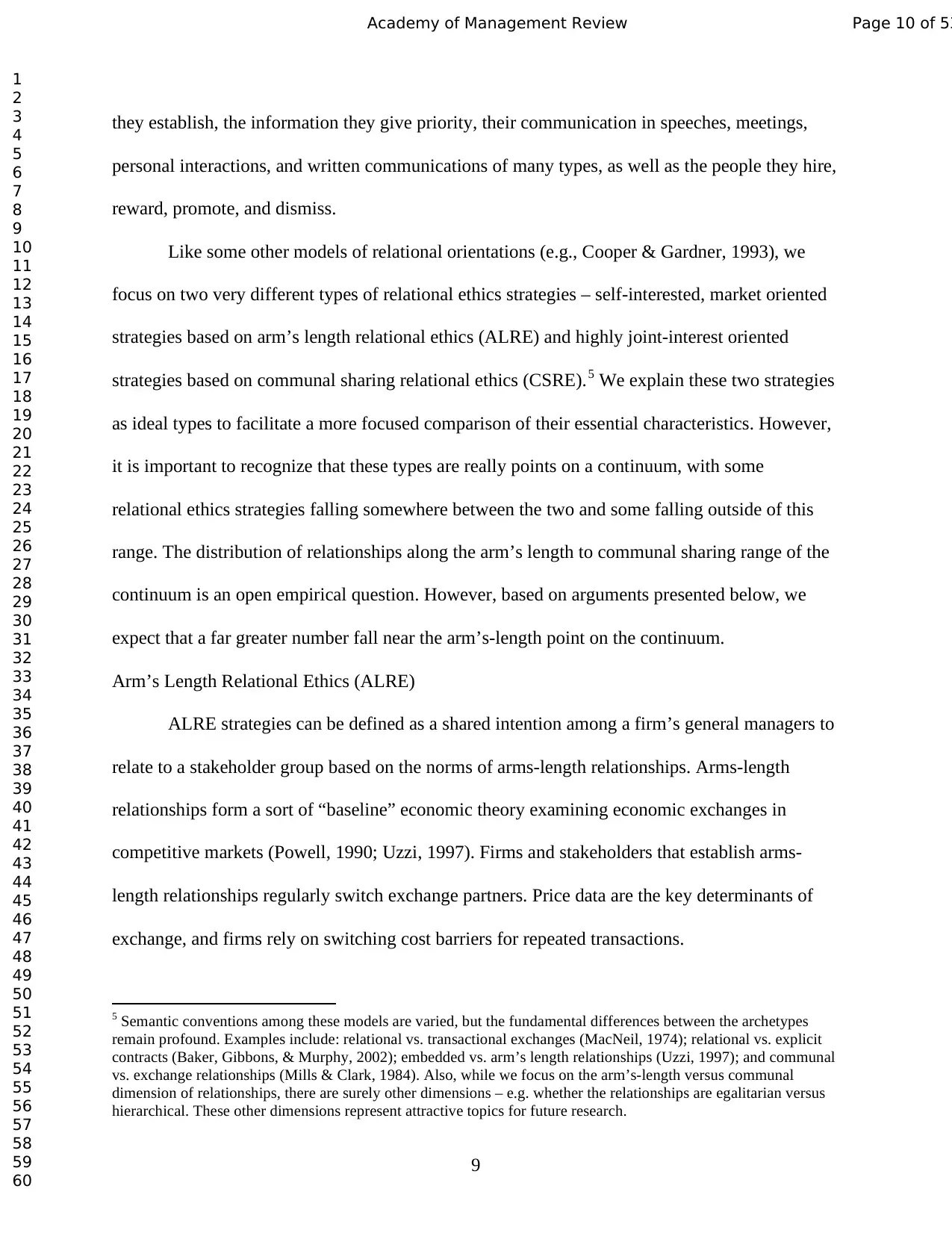
9
they establish, the information they give priority, their communication in speeches, meetings,
personal interactions, and written communications of many types, as well as the people they hire,
reward, promote, and dismiss.
Like some other models of relational orientations (e.g., Cooper & Gardner, 1993), we
focus on two very different types of relational ethics strategies – self-interested, market oriented
strategies based on arm’s length relational ethics (ALRE) and highly joint-interest oriented
strategies based on communal sharing relational ethics (CSRE).5 We explain these two strategies
as ideal types to facilitate a more focused comparison of their essential characteristics. However,
it is important to recognize that these types are really points on a continuum, with some
relational ethics strategies falling somewhere between the two and some falling outside of this
range. The distribution of relationships along the arm’s length to communal sharing range of the
continuum is an open empirical question. However, based on arguments presented below, we
expect that a far greater number fall near the arm’s-length point on the continuum.
Arm’s Length Relational Ethics (ALRE)
ALRE strategies can be defined as a shared intention among a firm’s general managers to
relate to a stakeholder group based on the norms of arms-length relationships. Arms-length
relationships form a sort of “baseline” economic theory examining economic exchanges in
competitive markets (Powell, 1990; Uzzi, 1997). Firms and stakeholders that establish arms-
length relationships regularly switch exchange partners. Price data are the key determinants of
exchange, and firms rely on switching cost barriers for repeated transactions.
5 Semantic conventions among these models are varied, but the fundamental differences between the archetypes
remain profound. Examples include: relational vs. transactional exchanges (MacNeil, 1974); relational vs. explicit
contracts (Baker, Gibbons, & Murphy, 2002); embedded vs. arm’s length relationships (Uzzi, 1997); and communal
vs. exchange relationships (Mills & Clark, 1984). Also, while we focus on the arm’s-length versus communal
dimension of relationships, there are surely other dimensions – e.g. whether the relationships are egalitarian versus
hierarchical. These other dimensions represent attractive topics for future research.
Page 10 of 53Academy of Management Review
1
2
3
4
5
6
7
8
9
10
11
12
13
14
15
16
17
18
19
20
21
22
23
24
25
26
27
28
29
30
31
32
33
34
35
36
37
38
39
40
41
42
43
44
45
46
47
48
49
50
51
52
53
54
55
56
57
58
59
60
they establish, the information they give priority, their communication in speeches, meetings,
personal interactions, and written communications of many types, as well as the people they hire,
reward, promote, and dismiss.
Like some other models of relational orientations (e.g., Cooper & Gardner, 1993), we
focus on two very different types of relational ethics strategies – self-interested, market oriented
strategies based on arm’s length relational ethics (ALRE) and highly joint-interest oriented
strategies based on communal sharing relational ethics (CSRE).5 We explain these two strategies
as ideal types to facilitate a more focused comparison of their essential characteristics. However,
it is important to recognize that these types are really points on a continuum, with some
relational ethics strategies falling somewhere between the two and some falling outside of this
range. The distribution of relationships along the arm’s length to communal sharing range of the
continuum is an open empirical question. However, based on arguments presented below, we
expect that a far greater number fall near the arm’s-length point on the continuum.
Arm’s Length Relational Ethics (ALRE)
ALRE strategies can be defined as a shared intention among a firm’s general managers to
relate to a stakeholder group based on the norms of arms-length relationships. Arms-length
relationships form a sort of “baseline” economic theory examining economic exchanges in
competitive markets (Powell, 1990; Uzzi, 1997). Firms and stakeholders that establish arms-
length relationships regularly switch exchange partners. Price data are the key determinants of
exchange, and firms rely on switching cost barriers for repeated transactions.
5 Semantic conventions among these models are varied, but the fundamental differences between the archetypes
remain profound. Examples include: relational vs. transactional exchanges (MacNeil, 1974); relational vs. explicit
contracts (Baker, Gibbons, & Murphy, 2002); embedded vs. arm’s length relationships (Uzzi, 1997); and communal
vs. exchange relationships (Mills & Clark, 1984). Also, while we focus on the arm’s-length versus communal
dimension of relationships, there are surely other dimensions – e.g. whether the relationships are egalitarian versus
hierarchical. These other dimensions represent attractive topics for future research.
Page 10 of 53Academy of Management Review
1
2
3
4
5
6
7
8
9
10
11
12
13
14
15
16
17
18
19
20
21
22
23
24
25
26
27
28
29
30
31
32
33
34
35
36
37
38
39
40
41
42
43
44
45
46
47
48
49
50
51
52
53
54
55
56
57
58
59
60
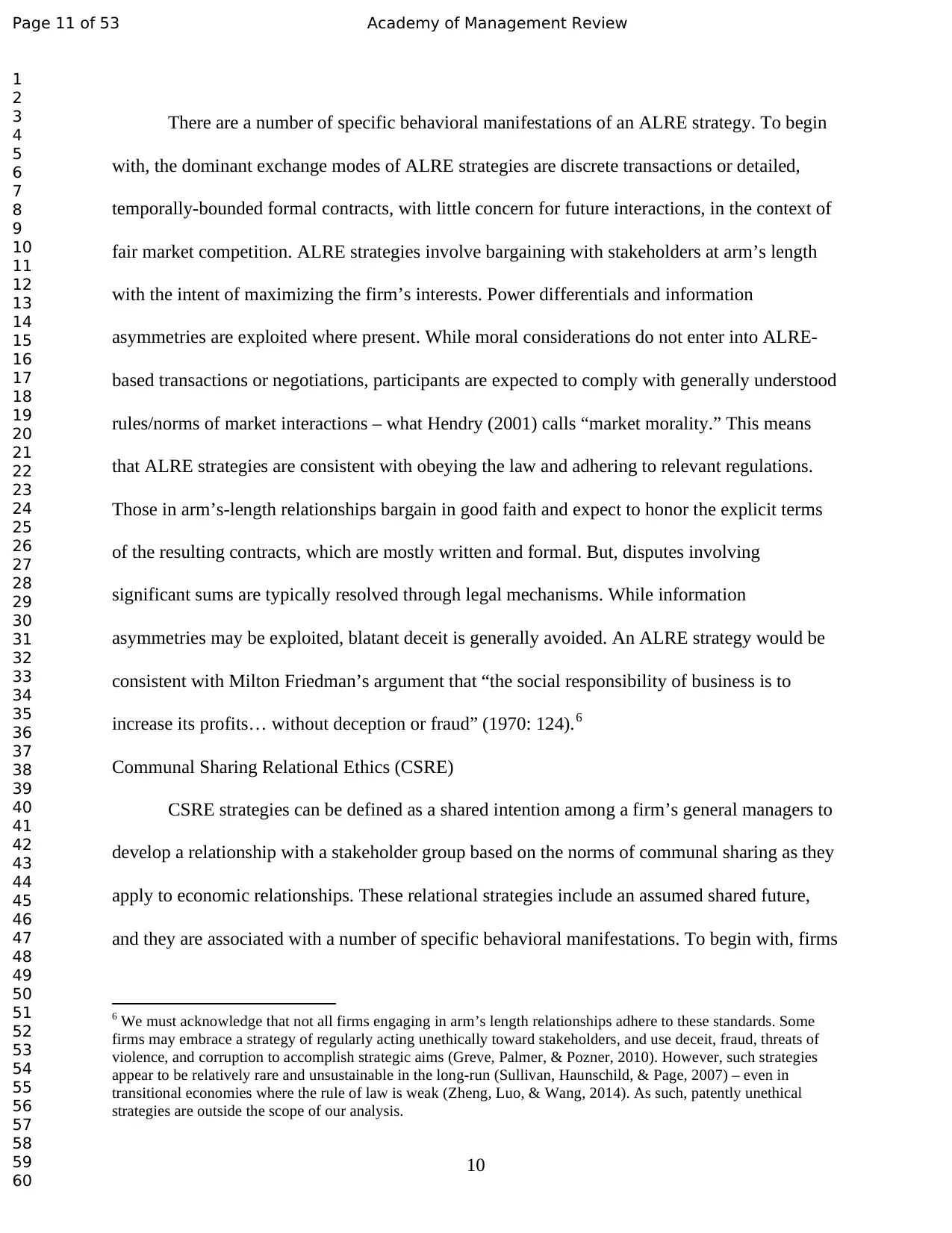
10
There are a number of specific behavioral manifestations of an ALRE strategy. To begin
with, the dominant exchange modes of ALRE strategies are discrete transactions or detailed,
temporally-bounded formal contracts, with little concern for future interactions, in the context of
fair market competition. ALRE strategies involve bargaining with stakeholders at arm’s length
with the intent of maximizing the firm’s interests. Power differentials and information
asymmetries are exploited where present. While moral considerations do not enter into ALRE-
based transactions or negotiations, participants are expected to comply with generally understood
rules/norms of market interactions – what Hendry (2001) calls “market morality.” This means
that ALRE strategies are consistent with obeying the law and adhering to relevant regulations.
Those in arm’s-length relationships bargain in good faith and expect to honor the explicit terms
of the resulting contracts, which are mostly written and formal. But, disputes involving
significant sums are typically resolved through legal mechanisms. While information
asymmetries may be exploited, blatant deceit is generally avoided. An ALRE strategy would be
consistent with Milton Friedman’s argument that “the social responsibility of business is to
increase its profits… without deception or fraud” (1970: 124).6
Communal Sharing Relational Ethics (CSRE)
CSRE strategies can be defined as a shared intention among a firm’s general managers to
develop a relationship with a stakeholder group based on the norms of communal sharing as they
apply to economic relationships. These relational strategies include an assumed shared future,
and they are associated with a number of specific behavioral manifestations. To begin with, firms
6 We must acknowledge that not all firms engaging in arm’s length relationships adhere to these standards. Some
firms may embrace a strategy of regularly acting unethically toward stakeholders, and use deceit, fraud, threats of
violence, and corruption to accomplish strategic aims (Greve, Palmer, & Pozner, 2010). However, such strategies
appear to be relatively rare and unsustainable in the long-run (Sullivan, Haunschild, & Page, 2007) – even in
transitional economies where the rule of law is weak (Zheng, Luo, & Wang, 2014). As such, patently unethical
strategies are outside the scope of our analysis.
Page 11 of 53 Academy of Management Review
1
2
3
4
5
6
7
8
9
10
11
12
13
14
15
16
17
18
19
20
21
22
23
24
25
26
27
28
29
30
31
32
33
34
35
36
37
38
39
40
41
42
43
44
45
46
47
48
49
50
51
52
53
54
55
56
57
58
59
60
There are a number of specific behavioral manifestations of an ALRE strategy. To begin
with, the dominant exchange modes of ALRE strategies are discrete transactions or detailed,
temporally-bounded formal contracts, with little concern for future interactions, in the context of
fair market competition. ALRE strategies involve bargaining with stakeholders at arm’s length
with the intent of maximizing the firm’s interests. Power differentials and information
asymmetries are exploited where present. While moral considerations do not enter into ALRE-
based transactions or negotiations, participants are expected to comply with generally understood
rules/norms of market interactions – what Hendry (2001) calls “market morality.” This means
that ALRE strategies are consistent with obeying the law and adhering to relevant regulations.
Those in arm’s-length relationships bargain in good faith and expect to honor the explicit terms
of the resulting contracts, which are mostly written and formal. But, disputes involving
significant sums are typically resolved through legal mechanisms. While information
asymmetries may be exploited, blatant deceit is generally avoided. An ALRE strategy would be
consistent with Milton Friedman’s argument that “the social responsibility of business is to
increase its profits… without deception or fraud” (1970: 124).6
Communal Sharing Relational Ethics (CSRE)
CSRE strategies can be defined as a shared intention among a firm’s general managers to
develop a relationship with a stakeholder group based on the norms of communal sharing as they
apply to economic relationships. These relational strategies include an assumed shared future,
and they are associated with a number of specific behavioral manifestations. To begin with, firms
6 We must acknowledge that not all firms engaging in arm’s length relationships adhere to these standards. Some
firms may embrace a strategy of regularly acting unethically toward stakeholders, and use deceit, fraud, threats of
violence, and corruption to accomplish strategic aims (Greve, Palmer, & Pozner, 2010). However, such strategies
appear to be relatively rare and unsustainable in the long-run (Sullivan, Haunschild, & Page, 2007) – even in
transitional economies where the rule of law is weak (Zheng, Luo, & Wang, 2014). As such, patently unethical
strategies are outside the scope of our analysis.
Page 11 of 53 Academy of Management Review
1
2
3
4
5
6
7
8
9
10
11
12
13
14
15
16
17
18
19
20
21
22
23
24
25
26
27
28
29
30
31
32
33
34
35
36
37
38
39
40
41
42
43
44
45
46
47
48
49
50
51
52
53
54
55
56
57
58
59
60
⊘ This is a preview!⊘
Do you want full access?
Subscribe today to unlock all pages.

Trusted by 1+ million students worldwide
1 out of 55
Related Documents
Your All-in-One AI-Powered Toolkit for Academic Success.
+13062052269
info@desklib.com
Available 24*7 on WhatsApp / Email
![[object Object]](/_next/static/media/star-bottom.7253800d.svg)
Unlock your academic potential
Copyright © 2020–2025 A2Z Services. All Rights Reserved. Developed and managed by ZUCOL.



